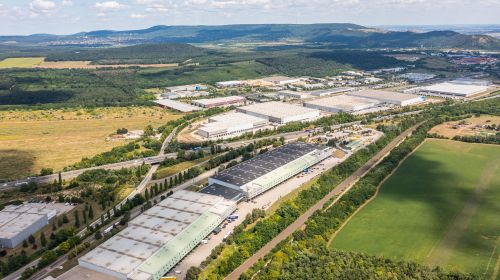The profits of being green
Green projects

The "Eurobuild" monthly magazine is available in three formats – on paper, in traditional HTML and in a responsive flipbook.
EditorialDid you go to Cannes hoping for some answers (or at least a few hints) and then come back even more confused? Because, apart from the official optimism that we’ve already become ac ...
Small talkAs EPP prepares to take over the management of 12 shopping centres with 0.5 mln sqm of space, we spoke to Agata Sekuła, a board member for real estate investment and commercialisat ...
Small talkMichał Kwaśniewski, a barrister and a partner of Quidea, tells us how family funds will work in Poland, and explains the complexities of how they are taxed and how they could also ...
FeatureMagdalena Szulc of Segro tells us about the company’s plans and shares her opinions on how new technology and ESG have been impacting the warehouse and logistics sector – as well a ...
Warehouse locationsData centres have been quietly opening across Poland, but they often consume more electricity than a small town. How will the country make use of the growing potential for investme ...


The "Eurobuild" monthly magazine is available in three formats – on paper, in traditional HTML and in a responsive flipbook.
EditorialDid you go to Cannes hoping for some answers (or at least a few hints) and then come back even more confused? Because, apart from the official optimism that we’ve already become ac ...
Small talkAs EPP prepares to take over the management of 12 shopping centres with 0.5 mln sqm of space, we spoke to Agata Sekuła, a board member for real estate investment and commercialisat ...
Small talkMichał Kwaśniewski, a barrister and a partner of Quidea, tells us how family funds will work in Poland, and explains the complexities of how they are taxed and how they could also ...
FeatureMagdalena Szulc of Segro tells us about the company’s plans and shares her opinions on how new technology and ESG have been impacting the warehouse and logistics sector – as well a ...
Warehouse locationsData centres have been quietly opening across Poland, but they often consume more electricity than a small town. How will the country make use of the growing potential for investme ...

Dutch studio Benthem Crouwel Architects together with Czech architects OVA have won the competition to redesign a quarter of Vítězné náměstí (Victory ...

According to the report released by research firm Spectis, “Modular construction market in Poland 2024-2029”, top 100 manufacturers of prefabricated b ...

The Globalworth Foundation has provided the authorities in Bucharest with office space for a Covid vaccination centre.

Panattoni BTS and Commercecon together support the establishment of the second Centaurus Foundation centre in Poland to help horses and other animals.

Shopee is ending its operations in Poland. The Asian e-commerce platform, which debuted in Poland in 2021, intends to focus on operations in other reg ...

Kreo, Ghelamco's Kraków office project, has achieved BREEAM certification at the Outstanding level. The building also has a WELL and Green Building St ...

Eurobuild Awards 2023 is behind us, but if you haven't yet gotten your hands on the special "Eurobuild" supplement prepared for the Gala evening, you ...

The next edition of our monthly magazine is now available both in paper and digital versions! Traditionally, the new issue was first sent to our confe ...

Welcome to Eurobuild FM! We invited an excellent expert to the today's episode – distinguished structural engineer Tristram Carfrae, deputy chair of w ...

We regret to inform you that Piotr Kroenke, long-time general director of GTC and co-creator of many of the company's successes, has passed away.

This latest episode of 'Eye to Eye' is hot out of the podcast oven and ready to listen to! Eurobuild’s guest today is Paweł Sapek, the head of Prologi ...

The UN Nansen Refugee Award award will go to Poland for the first time. According to the office of the UNHCR High Commissioner this year's regional wi ...

Czech developer CTP has been granted a EUR 200 mln loan from the European Investment Bank for the roll-out of its large-scale solar panel installation ...

IHG Hotels & Resorts and Novum Hospitality announced a long-term agreement that will double IHG’s presence in Germany to more than 200 hotels in almos ...

Kamil Kowa has become the new CEO of Savills in Poland. He is a member of the management board of the company, and for the past nine years has held th ...

The investment programme until 2030 worth more than PLN 1.5 bln has been approved for Katowice's Wojciech Korfanty Airport. The programme will include ...

Designers from Colliers, under the supervision of architect Kateřina Štenclova, prepared the concept for the Mercedes-Benz headquarters in Prague. The ...

Redkom has announced that it has finalised the sale of a retail park under construction in Bielsko-Biała to Newgate Investment. The 17,000 sqm retail ...

CTP has expanded its Polish land bank by nearly half a million sqm. The company has purchased investment land in four locations that provide the oppor ...

Intensive commercialization of the multifunctional Fern building under construction at Off Piotrkowska Center has begun. A modern building, the constr ...

Slovakian developer JTRE is launching its first project in Germany. The Nordhafen Living & Office multifunctional project will be built in the Europac ...

EPP is taking over the management of nine M1 shopping centres and three Power Parks from Metro Properties Polska. Some of Metro Properties Polska's em ...

Echo Investment and its subsidiary Archicom have started the construction of a primary school for 450 pupils on ul. Konstruktorska in the Służewiec su ...

According to the Berlin 2024 Residential Market Report by real estate financier Berlin Hyp and real estate service provider CBRE, purchase prices have ...

Wood & Company is planning the final third tranche of its acquisition of a stake in the Aupark shopping centre in Bratislava. The facility is currentl ...

The Symbiosy smart building platform developed in-house by Slovakian developer HB Reavis has been acquired by Massachusetts-based real estate experien ...

CTP has signed a lease agreement with the logistics service provider for an additional 2,000 sqm, thus the company will occupy a total of 13,000 sqm a ...